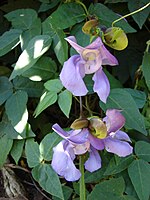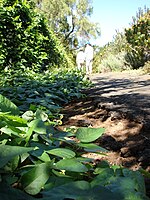Sigmoidotropis speciosa
| Sigmoidotropis speciosa | |
|---|---|

| |
| Scientific classification | |
| Kingdom: | Plantae |
| Clade: | Tracheophytes |
| Clade: | Angiosperms |
| Clade: | Eudicots |
| Clade: | Rosids |
| Order: | Fabales |
| Family: | Fabaceae |
| Subfamily: | Faboideae |
| Genus: | Sigmoidotropis |
| Species: | S. speciosa
|
| Binomial name | |
| Sigmoidotropis speciosa | |
| Synonyms | |
| |
Sigmoidotropis speciosa is a leguminous flowering plant in the family Fabaceae that originates in tropical South America and Central America.[1]
Description
[edit]
The purple, non-fragrant, invasive flowers of the "Phaseolus giganteus" are said to have snail or snail-shell shaped flowers, hence the origin of the common name. The multicolored, fragrant, non-invasive flowers of the Cochliasanthus caracalla are said to have corkscrew or nautilus-shell shaped flowers, hence the origin of that common name. Though some claim that the leaves of one species are darker and differently sized compared to the leaves of the other, it is difficult to distinguish between these two plants through foliage alone.
There have been multiple instances where both plants have been grown side by side for years and the discovery that they were not the same species was made only after the less mature plant finally bloomed. It is said that both plants are pollinated by ants so, without ants, the plant will produce few, if any, seeds,[2].
The snail vine, Phaseolus giganteus, is delightfully fragrant.[3] Flowers are a solid, pale purple. The flowers, which grow alone or in small groups[4] rather than in clusters, consist of four petals: one large wavy half-circle on the top, two tear-drop shaped petals that point inwards, and a thin, erect, curly petal sprouting from the center of the flower. Depending on the angle, the two bottom petals can appear to be a single petal that strongly resembles the large, upper petal. When this happens, the three main petals come together to form an open-clam shape. The center of the flower and the end of the thin, erect may have a small area of yellow and/or white but the color is usually faint and only noticeable upon close examination.

Immature flower buds often form fat half-crescents but, unlike the corkscrew vine, these buds are green, yellow, or brown. This plant might be more susceptible to aphids but is definitely invasive and has been compared by multiple growers to kudzu. Rapid growth combined with the ability of vines touching the ground to take root make this an invasive plant.[5][6] This plant has been known to regrow even after all foliage visible above ground has died from frost.[6]
References
[edit]- ^ "Sigmoidotropis speciosa (Kunth) A.Delgado". Plants of the World Online. Royal Botanic Gardens, Kew. Retrieved 8 February 2025.
- ^ "Phaseolus giganteus, Snail vine -".
- ^ [1]. "discusses characteristics of each in detail"
- ^ Almost Eden Snail Vine. "Description, growing, and sale information"
- ^ The Snail Vine - Confusion Reigns Supreme Archived 2020-02-19 at the Wayback Machine. "discusses characteristics of each in detail"
- ^ a b Desert Tropical - Snail Vine Archived 2016-08-17 at the Wayback Machine. "description"
